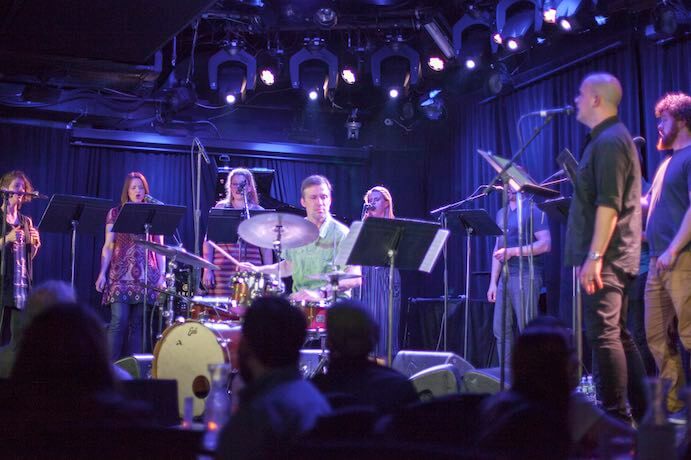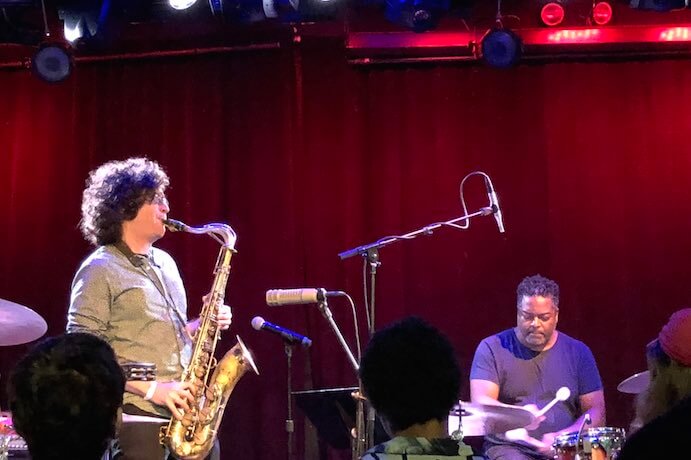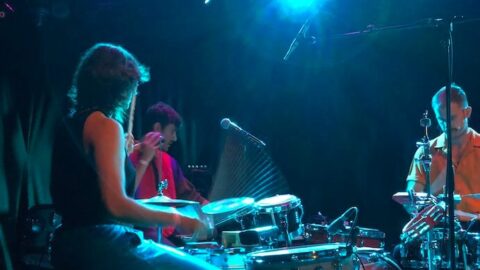New Amsterdam Records put on a rollicking showcase of its vibe and vision at Le Poisson Rouge on June 10th and 11th, 2018. Both New Amsterdam and LPR celebrated ten years in New York City, and partnered to present a seated dinner, standing industrial concert, and intimate backstage to celebrate NewAm’s anniversary. The seven hours of programming presented an incredible array of atmospheres and textures to an enthusiastic audience. There was a mini mosh to Deerhoof, amazement at the athleticism of Subtle Degrees, and open-hearted existentialism with Olivia Chaney. Pakistan and Henry Purcell got shout-outs. Jazz got everything from subtle nods to full throttle freedom. The audience was along for the ride and happy about it.
The June 10th crowd was oriented by an oral history of New Amsterdam with two of the co-founders Judd Greenstein and William Brittelle (third co-founder and composer Sarah Kirkland Snider was away for a premiere), and New Amsterdam content curator and recording artist Molly Joyce. Will Robin, moderating, read their earliest 2007 mission statement and asked why they started New Amsterdam Records. Musicians were seeking limitless work, Brittelle said, and arbitrary stylistic labels and locale boundaries were limiting emotionally honest work. So there were needs: permission and liberation to do whatever people wanted stylistically; a support mechanism and infrastructure; an expanded audience. “And my response to a problem,” said Greenstein, “is institution building.” A small organization could be more adaptable and flexible than rooted institutions, allowing artists and audiences to be their own taste makers and and create their own gates from multiple histories of music. After all, Brittelle noted frankly, classical music can look like “the soundtrack of imperialism” to people on the outside… but more on that later.

Arooj Aftab’s refashioned Southeast Asian and classical Pakistani styles were the perfect opening after a panel about history, progression, and nostalgia. Aftab layers intricate vocals over subtle electronic manipulations, jazz references, and heritage influence to create a tangible atmosphere of invitation and mystery. At one moment, she utilized simple, spacious piano filled by a motif of nearly aggressive glissandos from the harp and an eventual carillon of bell notes; later, the harp finished what Aftab’s voice began and submerged the audience in understated undulations. She sang only in Sufi, barely spoke with the audience, and maintained a peaceful intrigue; she held the stage and shifted the atmosphere.
New Amsterdam’s earliest mission statement in 2007 focused on creative freedom: music that slips between genres, allows for varied influences, and references more than formative (read: Western European) traditions. The organization quickly realized that a label isn’t sufficient; performance spaces and community are needed, too. Even as they focused on albums to make more definite artistic statements, they acknowledged digital music technology and listening habits. They compressed music for mp3 players and shuffle. They got flack. “But we have to examine mannerisms and what’s meaningful,” said Greenstein. Joyce was candid: as much as an album is a personal statement, it’s also exposure. And in the end, New Amsterdam has survived through multiple iterations of the fast changing record industry.
The second performance of the evening was Roomful of Teeth, and highlighted New Amsterdam’s success. The GRAMMY-winning group is known for its wide range of vocal techniques, new concert music commissioning, and partnerships with higher education. The Teeth stood circled around a drum kit and sang The Ascendant by Wally Gunn. The six movements highlighted their full range of effects and adventurous energy including call and response, solos growing out of a vocal trellis, imitative sirens, pointillistic part writing, vocal rhythms reminiscent of Brazilian folksong, and satisfying eight-part chords. Maria Zajkowski’s text and Teeth’s nuance were lost to muddy amplification and acoustics, but their prowess was obvious.

After Roomful of Teeth’s performance, the first evening closed with Olivia Chaney’s sly pop folk and relaxed banter. “Everyone calls me a folk singer, so I guess I should just do that,” she joked, a label which hardly does justice to her sophisticated writing. Opaline vowels and lush consonants evoked the rolling hills of England as much as her unabashed lyrics and evocative Celtic influences. Her writing for violin refrained from fiddling; tendril melodies, surprising turns of phrase, two covers of Purcell, and expert piano phrasing buried in echoes of Britten put conservatory training to discreet and savvy service of open-hearted songs.
In contrast to the first evening, where the audience was stationary and enjoyed dinner and drinks, June 11th was standing and mobile. People milled around the main room until someone realized the music wasn’t Spotify, but happening live. No Lands brought their blend of looping lyrics, synthesizer, and chill to LPR’s back gallery. Theirs is the music you want for your next posh underwater aquarium party, and immediately after came 45 minutes of of brazen athleticism from Subtle Degrees. It was new music’s version of a sporting event. Travis Laplante on tenor sax and drummer Gerald Cleaver were awe-inspiring, triumphant, and a touch of crazy. Each played mammoth solos. The set had one energetic silence, but its discrete sections unfolded as one arc of mastered frenzy. The piece reserved harmonic bass, tonal resolutions, and extended saxophone techniques for the very end including a brief flash of slipping between major and minor. Laplante played a marathon solo with circular breathing, pulsating register leaps. Eventually he sounded like a saxophone trio before landing on a single note for 45 seconds. The energy of the crowd built into applause and hollers before he exploded into extended technique that sounded like a swarm of bees.

Next, Molly Joyce fused vintage organ with DJ samples and melancholic, psychedelic vocals to create the ideal soundtrack for a road trip night shift. The intimate LPR gallery allowed the audience to crowd the stage and examine Joyce’s unusual instrument. This music is long stretches of flow, shadow forms on the horizon, and sudden spikes of activity. Then it was back out to the main space for TIGUE, the rock concert for intellectuals (pictured in feature image). Their music is so raucous and smart, they should be kicking off academic conference and shaking up convention centers. Their three interlocking drum kits and percussion music is repetitious enough to groove, varied enough to engage, and playful enough to explain their neon pants and quasi-jungle light projections. The group performed Quilts, a work from their latest record, and showed the tight collaboration honed from a current tour.
New Amsterdam has succeeded in a difficult space, cultivated expertise, and aimed at improved equality. The first night seven out of twelve musicians were women, with two of the three groups led by women. The second night, women were soloists, leads, or prominent in a typically male-dominated style. However, nearly everyone in the room looked the same. Stylistic and source diversity was discussed, but major genres like rap, R&B, or hip hop were conspicuously absent from an evening that otherwise traversed the globe and involved a glut of labels.
There is work to be done to connect institutional resources to emerging artists and audiences of increasingly varied backgrounds, and NewAm is positioned to extend new invitations. Brittelle frankly acknowledged that concert music appears to be entrenched in old power and exclusion, and that in discussions of diversity, it is one’s own responsibility to listen, serve, and engage people with different backgrounds. And so Deerhoof was the perfect closer to the NewAm party. Not only did their music careen through Baroque references, punk political throwdowns, and vocalist Satomi Matsuzaki’s sweet melodies, but their signature eclecticism and optimism in the face of challenge celebrated the best of New Amsterdam: an astonishing array of sound, increased women representation, global influences, and freedom to explore.
























